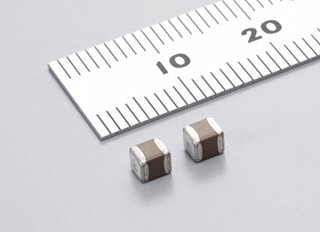source: Murata news
Murata Manufacturing Co., Ltd. has introduced a new monolithic ceramic capacitor, the first of its kind in the world at 1210 size (3.2 x 2.5mm) with a guaranteed operating temperature upper limit of 125°C, rated voltage of 100V, and a capacitance of 10μF. The maximum capacitance of 4.7μF of conventional monolithic ceramic capacitors has been extended to 10μF, a world-first for Murata Manufacturing Co., Ltd.
Background
With more advanced and multiple functions being incorporated into electronic equipment, the operating temperatures have become higher, and the need for a higher guaranteed operating temperature and larger capacitance in capacitors has grown. High-reliability monolithic ceramic capacitors are often used in the power supply circuits of network equipment and base stations, and the required capacitance has to date been ensured by using two or more 2.2μF and 4.7μF capacitors. The 10μF capacitor that we have currently introduced to the market allows the number of required capacitors to be reduced, and helps in making equipment more compact and more reliable. Moreover, the power supply circuits of network equipment and base stations are often used on 48V lines, prompting calls for capacitors with a rated voltage of 100V.
In response to these needs, Murata Manufacturing Co., Ltd. has designed this new monolithic ceramic capacitor, the first of its kind in the world at 1210 size with a guaranteed operating temperature upper limit of 125°C, rated voltage of 100V, and capacitance of 10μF.
Applications
48V power lines for network equipment, base stations, etc.
Part number
1210 size, X7S characteristics, 10μF, K tolerance, (±10%), rated voltage 100V:
GRM32EC72A106KE05
Electric characteristics
Temperature characteristics: X7S
Rated voltage: 100Vdc
Capacitance range: 10μF
Operating temperature range: -55°C to +125°C
External size
1210 size: L=3.2±0.3, W=2.5±0.2, T=2.5±0.2 (mm)
Production
Mass production under way at Izumo Murata Manufacturing Co., Ltd. since June 2016

































